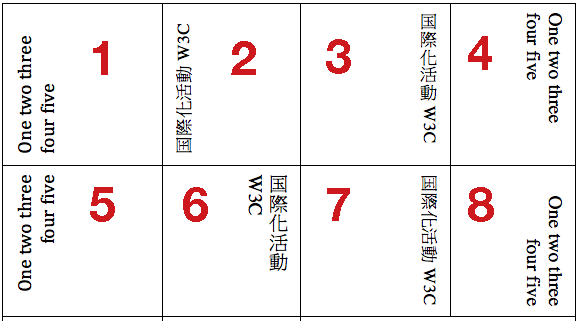- From: Richard Ishida <ishida@w3.org>
- Date: Fri, 10 Jul 2015 16:21:14 +0100
- To: fantasai <fantasai.lists@inkedblade.net>, www-style@w3.org
- Message-ID: <559FE2EA.3060608@w3.org>
On 04/07/2015 19:21, fantasai wrote: > On 06/02/2015 03:00 PM, Koji Ishii wrote: ... > writing-mode: horizontal-tb | vertical-rl | vertical-lr | sideways-rl > | sideways-lr; > text-orientation: mixed | upright | sideways (or sideways-rl) > > This preserves symmetry, and actually makes it even easier for > horizontal-script authors to get the two most common behaviors. > They no longer need to use 'text-orientation' unless they want, > specifically, upright text. So we have these cases then: > > Vertical Script Use Cases: > > Chinese, Japanese, Korean > writing-mode: vertical-rl; > + text-orientation: sideways | upright for inline tweaking > Mongolian > writing-mode: vertical-lr; > + text-orientation: sideways | upright for inline tweaking > > Horizontal Script Use Cases: > > Clockwise > writing-mode: sideways-rl; > Counter-clockwise > writing-mode: sideways-lr; > Upright LTR > writing-mode: vertical-lr; > text-orientation: upright; > Upright RTL > writing-mode: vertical-rl; > text-orientation: upright; > > * We would probably disable the 'svrt' feature for the sideways > writing modes, only enable it for vertical writing modes with > sideways text orientation. > > * Whether -rl or -lr is used depends sometimes on 'direction' > but most often on the layout context, e.g. right side or > left side of the page. > > Unsolved Use Cases: > > RTL top-to-bottom inline with CJK (rare, but does happen) > Ogham inline with CJK (very weird case, probably OK to not solve) > > I think it's OK for these last two cases to remain unsolved. > The first one would be nice to have, but isn't critical for > anyone, and the last case is mostly theoretical I think. the more i think about this, the less clear it becomes. i have attached an image that shows various numbered use cases. Fantasai, Koji, Florian, could you each indicate how you think CSS properties and values should be used to achieve each of the use cases? what's the difference between sideways-rl and vertical-rl? Presumably none for horizontal latin text. Or does this rotate all CJKM characters 90º clockwise? i'm wondering whether a better name for sideways-lr would be horizontal-bt, and possibly horizontal-tb for sideways-rl? what i'm not clear about wrt horizontal text that runs up the page is where the line start is. Is that defined? suppose i wanted to put the following text sideways latin text in a table header cell, and that the table cell height is restricted so that it only contains three words per line. "one two three four five" i'm pretty sure that the words "four five" would be on the second line (whether that's to the left or right of the first line), rather than appearing on the first and pushing 'one two' to the second line (which implies that the latin text has opposite-direction behaviour, and behaving like we currently expect rtl text to behave wrt line breaking. Doing that with text-orientations sounds odd). i'm assuming that this is what sideways-lr is for, but if an author used that would the word "one" and the word "four" to be touching the bottom of the container, or would "three" and "five" be touching the top of the container? And where is the line start? if you use Word to add some latin text to a table header that runs up the page, it shows the line start at the bottom of the cell. To do that you set direction to "Rotate all text 270º". i can't help thinking that we are struggling because we're trying to do two different things with one set of properties. i think that where text-orientation comes in is to affect the default orientation of vertical text only, ie. CJKM text, either by making the latin upright, or by making the CJK text run down the page. I'm inclined to think that support for latin text running up the page or arabic text running down it while embedded in CJKM text is something so rare that we don't need to worry about it – or at the very least we shouldn't let it continue to bog down progress on supporting the basic needs that people have been asking for for years now. i suspect that fitting latin text in a table heading so that it runs bottom to top, or top to bottom, is really a case of rotating the horizontally laid out text, and nothing more. (This would mean that only 'horizontal-bt' would put a second line on the right, and only 'horizontal-tb' would put it on the left.) ri PS: fwiw, here's an example of Latin text running up the page, however it is only in a loose association with the vertical-rl orientation of the chinese and japanese alongside it. I can count on one hand the other examples i've seen of text running in this direction. I assume that if this were translated into Arabic, that would run down the page but with the top of the glyphs to the left. https://www.flickr.com/photos/ishida/19391039009/
Attachments
- image/png attachment: vertical-test-cases.png

Received on Friday, 10 July 2015 15:21:25 UTC